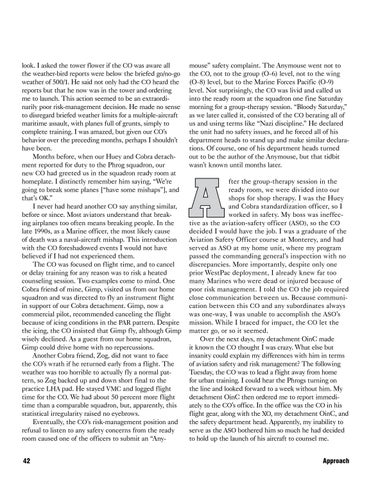look. I asked the tower flower if the CO was aware all the weather-bird reports were below the briefed go/no-go weather of 500/1. He said not only had the CO heard the reports but that he now was in the tower and ordering me to launch. This action seemed to be an extraordinarily poor risk-management decision. He made no sense to disregard briefed weather limits for a multiple-aircraft maritime assault, with planes full of grunts, simply to complete training. I was amazed, but given our CO’s behavior over the preceding months, perhaps I shouldn’t have been. Months before, when our Huey and Cobra detachment reported for duty to the Phrog squadron, our new CO had greeted us in the squadron ready room at homeplate. I distinctly remember him saying, “We’re going to break some planes [“have some mishaps”], and that’s OK.” I never had heard another CO say anything similar, before or since. Most aviators understand that breaking airplanes too often means breaking people. In the late 1990s, as a Marine officer, the most likely cause of death was a naval-aircraft mishap. This introduction with the CO foreshadowed events I would not have believed if I had not experienced them. The CO was focused on flight time, and to cancel or delay training for any reason was to risk a heated counseling session. Two examples come to mind. One Cobra friend of mine, Gimp, visited us from our home squadron and was directed to fly an instrument flight in support of our Cobra detachment. Gimp, now a commercial pilot, recommended canceling the flight because of icing conditions in the PAR pattern. Despite the icing, the CO insisted that Gimp fly, although Gimp wisely declined. As a guest from our home squadron, Gimp could drive home with no repercussions. Another Cobra friend, Zog, did not want to face the CO’s wrath if he returned early from a flight. The weather was too horrible to actually fly a normal pattern, so Zog backed up and down short final to the practice LHA pad. He stayed VMC and logged flight time for the CO. We had about 50 percent more flight time than a comparable squadron, but, apparently, this statistical irregularity raised no eyebrows. Eventually, the CO’s risk-management position and refusal to listen to any safety concerns from the ready room caused one of the officers to submit an “Any42
mouse” safety complaint. The Anymouse went not to the CO, not to the group (O-6) level, not to the wing (O-8) level, but to the Marine Forces Pacific (O-9) level. Not surprisingly, the CO was livid and called us into the ready room at the squadron one fine Saturday morning for a group-therapy session. “Bloody Saturday,” as we later called it, consisted of the CO berating all of us and using terms like “Nazi discipline.” He declared the unit had no safety issues, and he forced all of his department heads to stand up and make similar declarations. Of course, one of his department heads turned out to be the author of the Anymouse, but that tidbit wasn’t known until months later.
A
fter the group-therapy session in the ready room, we were divided into our shops for shop therapy. I was the Huey and Cobra standardization officer, so I worked in safety. My boss was ineffective as the aviation-safety officer (ASO), so the CO decided I would have the job. I was a graduate of the Aviation Safety Officer course at Monterey, and had served as ASO at my home unit, where my program passed the commanding general’s inspection with no discrepancies. More importantly, despite only one prior WestPac deployment, I already knew far too many Marines who were dead or injured because of poor risk management. I told the CO the job required close communication between us. Because communication between this CO and any subordinates always was one-way, I was unable to accomplish the ASO’s mission. While I braced for impact, the CO let the matter go, or so it seemed. Over the next days, my detachment OinC made it known the CO thought I was crazy. What else but insanity could explain my differences with him in terms of aviation safety and risk management? The following Tuesday, the CO was to lead a flight away from home for urban training. I could hear the Phrogs turning on the line and looked forward to a week without him. My detachment OinC then ordered me to report immediately to the CO’s office. In the office was the CO in his flight gear, along with the XO, my detachment OinC, and the safety department head. Apparently, my inability to serve as the ASO bothered him so much he had decided to hold up the launch of his aircraft to counsel me. Approach





















